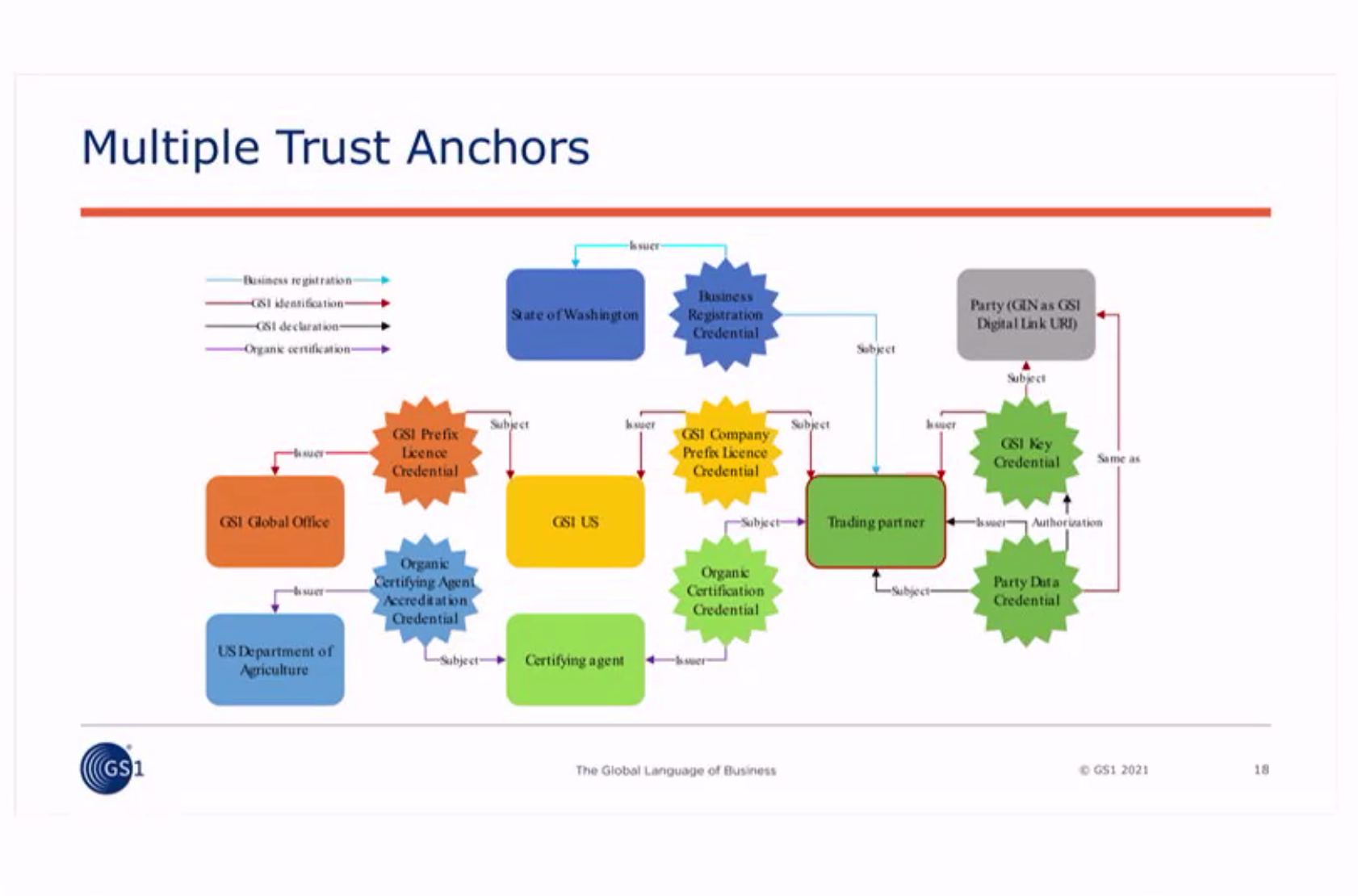- From: Dmitri Zagidulin <dzagidulin@gmail.com>
- Date: Wed, 3 Nov 2021 14:14:47 -0400
- To: MXS Insights <mxsinsights@gmail.com>
- Cc: Credentials Community Group <public-credentials@w3.org>, public-vc-edu@w3.org
- Message-ID: <CANnQ-L6fbw9WyxhNzbZcLKKgsDUDZ-rcipqfesbk4wB0EHmB6Q@mail.gmail.com>
Hi Michael,
Ahhh yeah, I was sorry to have missed that session! Do you happen to know,
does GS1 have a proposed linking property/mechanism?
On Wed, Nov 3, 2021 at 2:10 PM MXS Insights <mxsinsights@gmail.com> wrote:
> Dmitri,
>
> This sounds very interesting and very similar to some of the challenges
> that GS1 was raising at IIW around the current VC Standard. Sharing a
> screen shot from one of the presentations.
>
>
> Michael Shea
>
>
>
>
> On Nov 3, 2021, at 6:59 PM, Dmitri Zagidulin <dzagidulin@gmail.com> wrote:
>
> Oliver,
> Great question. Some thoughts on that over here:
> https://github.com/w3c/vc-data-model/issues/831#issuecomment-959772827
>
> On Wed, Nov 3, 2021 at 6:48 AM Oliver Terbu <oliver.terbu@mesh.xyz> wrote:
>
>> This sounds interesting.
>>
>> @Dmitri Zagidulin <dzagidulin@gmail.com> would it be possible to link
>> two DIDs through one VC together with this approach?
>>
>> Oliver
>>
>> On Wed, Nov 3, 2021 at 2:57 AM Dmitri Zagidulin <dzagidulin@gmail.com>
>> wrote:
>>
>>> I've been hearing the subject of cryptographically binding links between
>>> VCs and other VCs (or other external resources like PDFs) come up more and
>>> more lately (it's especially been prevalent in the VC Edu community). I'd
>>> like to put forth a proposal that hopefully addresses the use case, or at
>>> very least starts a conversation. Motivation
>>>
>>> 1. Provide a mechanism with which to link multiple VCs together (as
>>> peers or as parent/child relationships).
>>> 2. Provide examples of a general purpose hashlink
>>> <https://datatracker.ietf.org/doc/html/draft-sporny-hashlink> mechanism
>>> (useful for linking VCs, but also for linking to external images, PDFs, and
>>> other files).
>>>
>>> Background / Use Cases
>>>
>>> There are many use cases that involve binding multiple Verifiable
>>> Credentials together. For example, a simple Student ID credential can
>>> consist of an overall container credential, which links to several
>>> individual credentials (such as a student Photo credential, a proof of
>>> enrollment at a particular university, a proof of age, etc).
>>>
>>> Note that this is different than binding multiple credentials together
>>> in a Verifiable Presentation (and having the presenter sign the VP). In the
>>> VP case, the binding just means "this presenter is authenticating the
>>> handing over of these unrelated credentials". Whereas in the linked VC
>>> case, the credentials are aware of each other, and the peer or hierarchical
>>> relationship is built into the VC itself.
>>> Proposal
>>>
>>> This proposal introduces two new related properties: anchoredResource
>>> and contentHash.
>>> Anchored Resource
>>>
>>> An anchored resource points to one or more linked or bound resources. It
>>> can appear in the credentialSubject section (which implies that the
>>> resource is linked to the subject), or in the top level credential (same
>>> level as issuer, issuanceDate, etc), which implies that the resource is
>>> linked to the credential itself.
>>> Content Hash
>>>
>>> A contentHash property provides a way to refer to an external resource
>>> via a Hashlink.
>>> Example
>>>
>>> Here's what this would look like, using a mock Student ID credential.
>>>
>>> {
>>> "@context": [
>>> "https://www.w3.org/2018/credentials/v1",
>>> "https://w3id.org/security/suites/ed25519-2020/v1"
>>> ],
>>>
>>> "id": "urn:uuid:123445",
>>> "type": ["VerifiableCredential", "StudentIdCredential"],
>>> "issuer": {
>>> "id": "did:key:....",
>>> "image": {
>>> "id": "https://example-university.edu/logo.png",
>>> "contentHash": "hl:<hashlink to the logo url above>"
>>> },
>>> "name": "Example University"
>>> },
>>> "issuanceDate": "2020-04-03T00:00:00.000Z",
>>> "expirationDate": "2020-12-15T00:00:00.000Z",
>>> "name": "Student Identification Document",
>>> "anchoredResource": [{
>>> "id": "urn:uuid:<URN of the related photo id credential>",
>>> "contentHash": "hl:<hashlink to the related photo id credential>"
>>> }],
>>> "proof": {
>>> // ed25519 signature proof goes here
>>> }}
>>>
>>> Note the two usages of contentHash in the example. In the issuer, the
>>> hashlink <https://datatracker.ietf.org/doc/html/draft-sporny-hashlink> is
>>> to a resolvable resource (a regular .png hosted somewhere), and its only
>>> purpose is to cryptographically bind the exact version of the logo. (The
>>> alternative way to do that is to embed the full image in a
>>> data:image/png;base64,iVBORw0KGgoAA... url. Except those tend to make
>>> the VC too large for some use cases, such as fitting onto a QR Code.)
>>> Whereas in the anchoredResource, the hashlink is to a non-resolvable
>>> urn:uuid: type URN, which only makes sense if both the student id and
>>> the photo credential were presented to the verifier.
>>>
>>> Let's continue the conversation over at
>>> https://github.com/w3c/vc-data-model/issues/831 !
>>>
>>
>
Attachments
- image/png attachment: PastedGraphic-1.png

Received on Wednesday, 3 November 2021 18:15:22 UTC